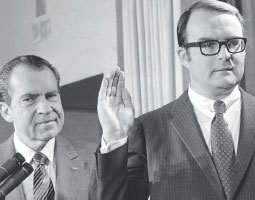
Eliminating the EPA: Can it be done, and would we regret it?
Legislation proposed by a House Republican would eliminate the Environmental Protection Agency by the end of 2018. Some say it's political grandstanding, while...
When the newly formed Environmental Protection Agency was taking its first steps under Administrator William Ruckelshaus, leadership needed a way to measure whether or not they were making good policy decisions.
Because right from its start, said A. James Barnes, former chief of staff for Ruckelshaus, environmental groups and industry were attacking the agency.
“We all often thought if Ruckleshaus made a decision and both General Motors and Ralph Nader squealed, maybe you’d cut it about right,” Barnes said. “If only one of them squealed, you wondered maybe did I miss something.”
The EPA turns 46 this December. What started as an executive order under President Richard Nixon, a $1 billion budget, 4,000 employees, and a goal of making American air clean again, the agency today boasts a workforce of more than 15,000 people, a budget of $8 billion and oversees everything from mercury spills in high school science labs to nuclear waste.
And there are some in Congress who want to eliminate it.
Earlier this month, Rep. Matt Gaetz (R-Fla.) proposed H.R. 861, a bill to terminate the EPA by the end of 2018.
The text of the bill wasn’t immediately available, but in a statement published in the Gulf Breeze News, Gaetz called the legislation “necessary.”
“It is the states and local communities that are best positioned to responsibly regulate the environmental assets within their jurisdictions,” Gaetz said in his statement. “The American people are drowning in rules and regulations promulgated by unelected bureaucrats; and the Environmental Protection Agency has become an extraordinary offender. Our small businesses cannot afford to cover the costs associated with compliance, too often leading to closed doors and unemployed Americans.”
And EPA isn’t the only agency with a target on its back. Rep. Thomas Massie (R-Ky.) introduced legislation to eliminate the Department of Education, also by the end of 2018.
Reorganization authority
Streamlining government at the department level isn’t a new concept. In early 2012, President Barack Obama announced he would be asking Congress to reinstate presidential reorganization authority, which had expired in 1984.
The authority lets presidents reorganize smaller organizations, or create entirely new ones, like the EPA, for example.
Between 1932 and 1984, presidents submitted more than 100 plans using this authority, according to the Congressional Research Service.
“The terms of the authority delegated to the President varied greatly over the century,” CRS reported. “During some periods, Congress delegated relatively broad authority to the President, while during others the authority was more circumscribed.”
At the time Obama wanted the authority reinstated — he ultimately was unable to get the authority from Congress — he proposed consolidating six agencies into one: Department of Commerce’s core business and trade functions, the Export-Import Bank, the Overseas Private Investment Corporation, the Small Business Administration, the U.S. Trade and Development Agency and the Office of the U.S. Trade Representative.”
People, places, jurisdictional things
A major factor to consider when mulling the elimination or overhaul of an agency is the timeline, said Danny Werfel, former controller at the Office of Management and Budget under Obama. Werfel also served as acting commissioner at the Internal Revenue Service. His comments to Federal News Radio relate not specifically to the pros and cons of reforming the EPA , but rather the particular challenges of this type of reform.
“Even when you’re downsizing a footprint or streamlining a set of activities, dismantling something, if you’re going to do it in a way that ensures the right equities are in place, that ensures fairness, that there’s clarity in terms of what the world looks like once the organization is dismantled, that can require a lot of planning, and a lot of skill in terms of public administration, making sure that that all gets carried out effectively,” said Werfel, who is now with the Boston Consulting Group.
Major changes require tough conversations with employees, Werfel said. You have to engage with the workforce and explain what is going to happen and how it of eliminating EPA from a public policy perspective will affect their jobs. As for the leadership that’s handling the overhaul, they should be prepared for pushback from individuals, unions and stakeholders, who want to either slow the change or prevent it from happening.
Cutting off an agency also has a geographical impact. A community that’s home to a large federal office building, laboratory or other facility is going to notice when that property is empty.
“There have been moments in time where federal agencies have tried to consolidate offices, shut down offices,” Werfel said. “That has an impact both in terms of the people potentially losing jobs, or having to shift jobs from the geography; local politicians can get involved. So either Congress and representatives or senators who represent that district or that state will raise concerns if jobs are being eliminated from their jurisdictions.”
Major changes to an agency can also directly impact members of Congress, Werfel said. If responsibilities are shifted from one jurisdiction to another, the chairman of one congressional committee that normally oversees a certain aspect of agency mission might lose that authority when it’s shifted to another area of oversight.
Latest Management News
A shifting of responsibilities is another factor to consider, especially in a scenario involving an agency like the EPA, the services of which include inspections, enforcement and advocacy.
“When you talk about shutting down an organization, what activities are you going to eliminate and will no longer exist? What activities are going to shift to other authorities?” Werfel said, adding that moving EPA responsibilities to the state and local levels — without identifying and carefully planning for all the various implications and contingencies — could create a lot of disruption and confusion that would undermine the goals of the intended reform.
For the EPA specifically, moving responsibilities to the states would create a whole new set of problems, said Clifford Villa, an assistant law professor at the University of New Mexico, and a former legal counsel for the EPA.
If the states could do the job of the EPA, they already would be, Villa argued. But the EPA provides checks and balances when state governments are wrestling with an environmental issue.
“People who have every good intention in state agencies, they love knowing the EPA is there, because they need that 800-pound gorilla,” Villa said. “If people won’t negotiate with the state department of ecology, they can credibly say, well if you don’t, then you’re going to have to deal with the EPA. More often than not that isn’t a hollow threat, because they would have to deal with the EPA.”
That doesn’t mean the EPA is unstoppable, Villa said, and in fact during his time at EPA, sometimes there was a political reason why something couldn’t be done, and then the state would be called in for help. But a federal presence provides an independence that a state or local government can’t match, not to mention many laws would need to be rewritten to remove the EPA as the responsible party.
“There’s a lot of statutes that specifically identify obligations of the EPA and not any other agency, so you would need to change not just one law, but a lot of them,” Villa said.
A new agency
The laws governing the EPA have not remained untouched in their 46-year history. But first, it’s important to understand the original mission of the EPA.
“A majority of EPA’s mission can and should be seen through the public health lens,” said Scott Fulton, president of the Environmental Law Institute, who served as general counsel for the EPA, and as the acting EPA deputy administrator during the first year of the Obama administration. “Not to say that other environmental considerations are unimportant, but I think the ones that have the greatest gravity both for purposes of the people that work at the agency but also the public the agency serves, are those that are about environmental public health.”
While the mission of the EPA has always been protecting human health and the environment, Villa echoed, “the regulatory programs to protect human health have shifted somewhat.”
Nixon created the EPA in 1970, the same year Congress passed the Clean Air Act.
Smog, smoke and acid rain made it easy to see that the air was dirty. Congress passed the Clean Water Act passed, amid images of burning rivers, Villa said.
Barnes said he remembers the start of the EPA as an exciting time, but also one with a lot of work trying to put together bits and pieces of 15 different cabinet departments and federal agencies.
“People were looking for direction on what they ought to do,” Barnes said. “Ruckleshaus had the challenge of both trying to bring some organizational structure to the agency, as we looked at what the legal authorities were, it was very mixed. For example, the Clean Air Act as we know it, was signed in December of 1970. That gave kind of a blueprint going forward as to what the EPA was going to do. On the other hand, with water pollution, the federal authorities mostly dealt with the ability to deal with interstate pollution. It was a very complicated mechanism.”
As the laws were put into place, Barnes explained, the general set up was for the federal government to set standards, delegate programs to the states, and provide federal grant money and backstops for those programs.
In the 1980s and 1990s, Congress made some “major mid-term corrections to the laws”, Barnes said, “additional things that needed to be done, some things that needed to be changed.”
“All of those laws and amendments to the major laws, came about with what I would say was strong, bipartisan support,” Barnes said, offering as an example the Endangered Species Act.
From the mid-1990s and onward, as the administrations changed, Barnes said, you can follow the pendulum swings on policies related to the environment.
“The administration changes, they try to put a new approach in place, it gets challenged in court, the court knocks it down, another administration comes in, takes a different tact,” Barnes said.
As recently as last summer, Congress gave EPA more power to fight toxic chemical exposure, said Robert Percival, director of the University of Maryland’s environmental law program.
“If anything we should be going in the other direction of giving them a greater budget and more staff to carry out the new responsibilities that this very Congress gave them,” Percival said.
What direction Congress will ultimately take on the EPA remains to be seen, though the EPA alums and experts who spoke with Federal News Radio were skeptical Gaetz’s bill would actually get traction.
But that doesn’t mean they aren’t open to looking at how EPA can improve on its mission.
“There is clearly more sophistication at the state level and more capacity at the state level than at the beginning of EPA’s tenure,” Fulton said. “There’s a culture valuing environmental performance that has powerfully taken hold and a large swath of the business community that’s reinforced by customer value and shareholder demands. There’s also the fact that the high-impact, low-relative-cost of environmental improvements have largely been realized at this point. Additional environmental gains are coming at a higher relative cost. This question of reform should be viewed against this backdrop and should we look for ways to update our system of protection and make work better and more efficiently, absolutely. But we also need to take care not to erode the essential ingredients of a system that’s been a driver for the environmental quality that we enjoy today.”
Copyright © 2025 Federal News Network. All rights reserved. This website is not intended for users located within the European Economic Area.
Related Stories

Support for open government, social media freedom gaining ground after agencies told to button up




